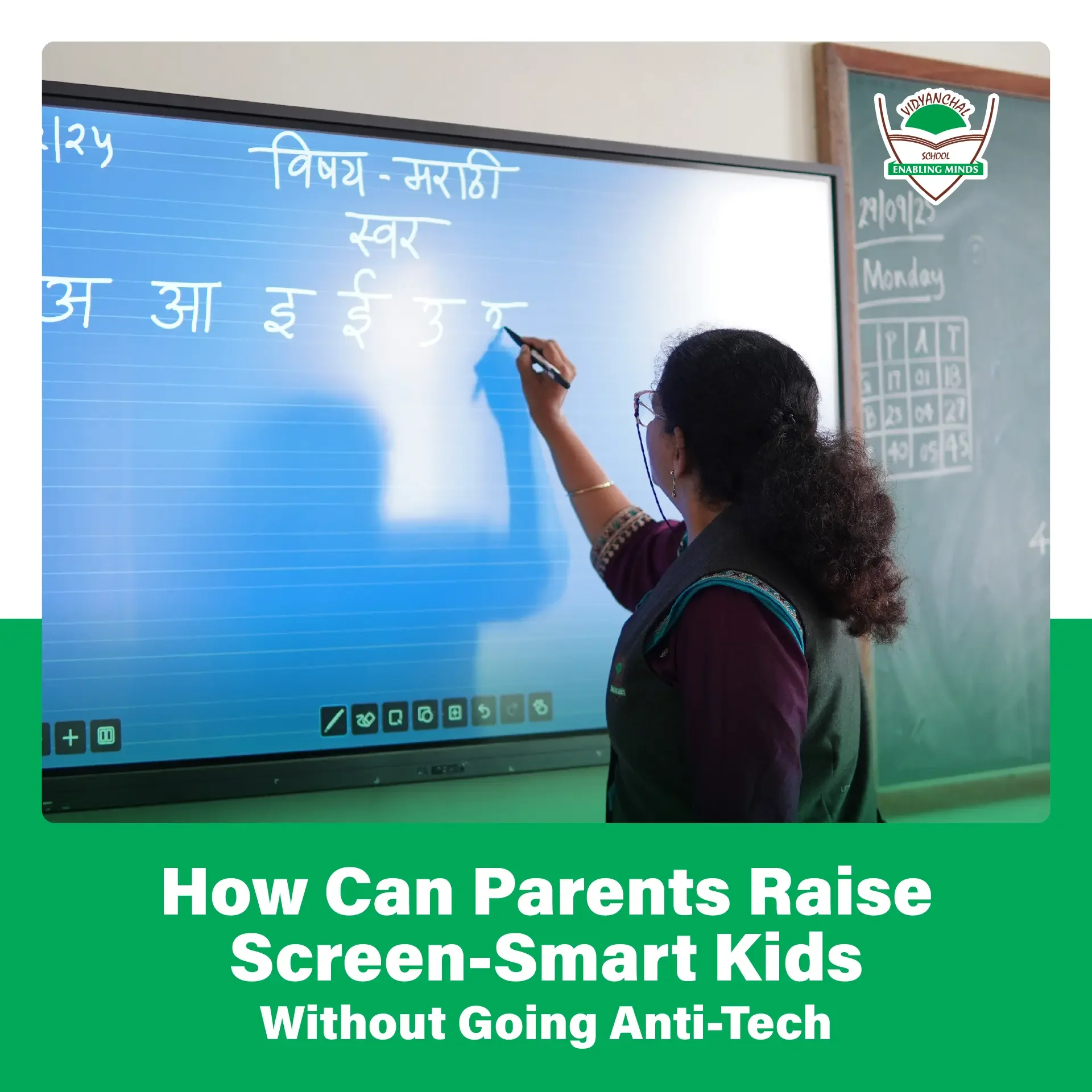Screens are everywhere. From smartphones and tablets to smartboards in classrooms and laptops for homework, today’s children are growing up in a world where technology is not just an accessory—it’s a way of life. But as screens become integral to learning, entertainment, and even socialising, parents are left wondering: How do we ensure our kids are screen-smart without going completely anti-tech?
At Vidyanchal High School (VHS), we believe technology is not the enemy—it’s a tool. When used thoughtfully, it can enhance creativity, support holistic education, and prepare students for the future. The key lies in balance, boundaries, and building awareness.
The Screen Time Dilemma
Parents often hear alarming statistics. According to a 2022 survey by Common Sense Media, kids aged 8–12 spend an average of 5 hours a day on screens outside of schoolwork, while teens spend about 7.5 hours daily. In India, the numbers are rising too: a 2023 IAMAI-Kantar report found that 45% of children between 5–11 years are active internet users.
While too much screen time has been linked with shorter attention spans and sedentary lifestyles, it’s equally important to note that educational apps, interactive platforms, and digital creativity tools can improve learning outcomes by up to 30% (UNESCO, 2023). The challenge, therefore, is not screens themselves, but how kids engage with them.
Why Going Completely Anti-Tech Doesn’t Work
It’s tempting to imagine a “zero screens” childhood. But in reality, digital literacy is as important as reading and writing today. Research by the World Economic Forum shows that 90% of jobs across all sectors will require basic digital skills by 2030. Denying children the opportunity to learn how to use technology responsibly can leave them underprepared for the future.
Moreover, technology often powers creativity: coding games, digital art, music apps, or even collaborative platforms allow students to learn by doing. At VHS, for instance, students are encouraged to experiment with tech-enabled learning tools alongside traditional classroom discussions.
Building Screen-Smart Kids: Strategies for Parents
1. Shift from Quantity to Quality
Not all screen time is created equal. Watching random videos online is different from using a coding app or reading on a digital library. Parents can guide children to use screens for creation rather than consumption.
- Encourage children to make presentations, design artwork, or record their own stories using digital tools.
- Replace passive entertainment with interactive educational apps recommended by schools.
At VHS, teachers integrate technology into projects that stimulate critical thinking and creativity, ensuring screen time adds value.
2. Model Healthy Screen Behaviour
Children learn more from what parents do than what they say. If kids see parents constantly scrolling during dinner, they perceive it as normal. Creating family screen rules helps establish balance.
Examples include:
- No phones at mealtime.
- Device-free family time on weekends.
- Parents explaining their own productive screen use (like reading articles or work research).
This kind of transparency shows kids that screens are tools, not toys.
3. Set Boundaries, Not Bans
Banning technology outright often backfires, creating secrecy and overuse when kids do get access. Instead, set time-based and purpose-based rules.
- The American Academy of Pediatrics recommends:
- No screen time (except video calling) for children under 18 months.
- Up to 1 hour a day of high-quality content for children 2–5 years.
- Consistent limits for older children, tailored to their needs.
Using parental control tools, timer apps, and co-viewing content can ensure screen use remains safe and balanced.
4. Encourage Outdoor and Offline Play
Sports, arts, and physical activities are essential to balance screen exposure. At VHS, sports are not just extracurricular—they’re an integral part of the school’s philosophy of holistic education. With football, basketball, cricket, and skating, students are encouraged to move, play, and learn teamwork away from screens.
Data proves this balance matters: students who engage in at least 1 hour of physical activity daily show 20% better focus and 15% higher test performance (CDC, 2022).
5. Use Technology for Connection, Not Isolation
One of the biggest parental concerns is that screens isolate children. But when guided, technology can actually bring families closer. Watching documentaries together, video calling relatives, or co-creating digital projects can transform screen time into bonding time.
At VHS, group activities often include collaborative digital tasks, ensuring students see technology as a medium for teamwork, not loneliness.
6. Teach Digital Literacy and Responsibility
Being screen-smart isn’t just about limiting hours—it’s about understanding how to use technology responsibly. Children must learn:
- How to evaluate credible information online.
- Why cyber safety and privacy matter.
- The impact of social media on mental health.
A 2023 study by McAfee revealed that 85% of Indian children have shared personal information online, often without realising the risks. This shows why digital literacy education at school and home is vital. VHS addresses this with awareness workshops, safe digital practices, and parent-student sessions to create a culture of responsibility.
What Parents Can Learn from Schools Like VHS
At Vidyanchal High School, balance is central to education. Technology is integrated into learning, but never at the cost of sports, arts, or personal interaction.
- Blended Learning: Smartboards and digital tools support, not replace, discussions and hands-on experiments.
- Holistic Curriculum: Equal importance is given to academics, athletics, and creative arts, ensuring screens don’t overshadow physical and social growth.
- Parent Engagement: Through regular communication, workshops, and feedback channels, VHS partners with parents to set healthy digital norms at home.
This approach ensures students see technology as a bridge to knowledge, creativity, and connection, not an escape from reality.
The Indian Parent’s Perspective
In India, where extended families and cultural values emphasise balance, the conversation around screens is uniquely nuanced. According to a 2023 LocalCircles survey, 63% of Indian parents worry about their child’s screen addiction, but 72% also believe digital learning is unavoidable.
This duality reflects the need for an approach like VHS’s—where tech is embraced without overwhelming the child’s development. Parents don’t need to become anti-tech; they need to become pro-balance.
Quotes That Resonate
- “The goal is not to shield children from technology but to empower them to use it wisely.” – UNESCO, 2023
- “Physical play, creative exploration, and technology must go hand in hand for balanced child development.” – NEP 2020 Guidelines
These align with VHS’s philosophy: holistic education that prepares students for a rapidly changing world.
Final Thoughts
Raising screen-smart kids is not about bans, guilt, or constant battles. It’s about teaching children to treat screens as tools—not crutches.
By focusing on quality over quantity, setting clear boundaries, encouraging outdoor activities, and building digital literacy, parents can ensure their children thrive in the digital age.
And with schools like Vidyanchal High School leading by example—through holistic education that integrates academics, sports, arts, and responsible tech use—families don’t have to choose between being pro-tech or anti-tech. Instead, they can raise a generation that is balanced, confident, and future-ready.











